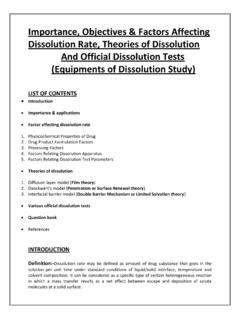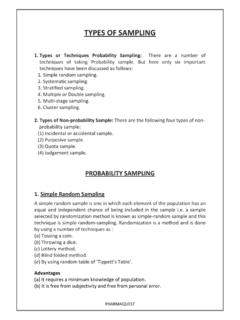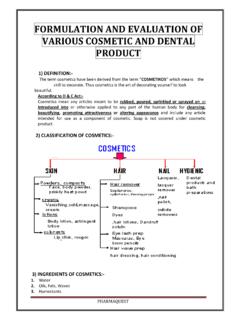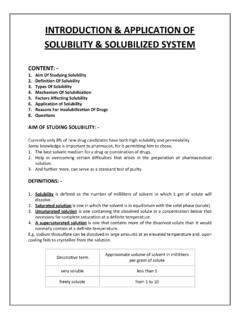Transcription of PHARMACEUTICAL PACKAGING, COMPONENT AND …
1 PHARMACEUTICAL packaging , COMPONENT AND EVALUATION Guided by: Prepared by: Dr. M. R. Mehta Bulchandani Hitesh H Roll No: 112450808005 M. Pharm Sem - II Department of Pharmaceutics and PHARMACEUTICAL Technology Shri Sarvajanik Pharmacy College, Mehsana M. PHARM SEM II PHARMACEUTICAL packaging , COMPONENTS & EVALUATION 1 HITESH BULCHANDANI SSPC, MEHSANA INDEX SR. NO. CONTENTS 1 IInnttrroodduuccttiioonn 2 TTyyppeess ooff ppaacckkaaggiinngg ssyysstteemmss 3 IIddeeaall RReeqquuiirreemmeennttss ooff PPhhaarrmmaacceeuuttiiccaall PPaacckkaaggiinngg MMaatteerriiaallss 4 CCrriitteerriiaa ffoorr tthhee sseelleeccttiioonn ooff ppaacckkaaggee ttyyppee aanndd ppaacckkaaggiinngg mmaatteerriiaall 5 VVaarriioouuss ppaacckkaaggiinngg mmaatteerriiaallss && cclloossuurreess 6 PPaacckkaaggiinngg eevvaalluuaattiioonn 7 DDoossaaggee ffoorrmmss aanndd ppaacckkaaggee ffoorrmmss 8 RReegguullaattoorryy aassppeeccttss ooff tthhee
2 Pphhaarrmmaacceeuuttiiccaall ppaacckkaaggiinngg 9 SSttuuddyy QQuueessttiioonnss 10 RReeffeerreennccee M. PHARM SEM II PHARMACEUTICAL packaging , COMPONENTS & EVALUATION 2 HITESH BULCHANDANI SSPC, MEHSANA INTRODUCTION DEFINITION: Packing: Packing consists of enclosing an individual item, or several items, in a container, usually for shipment or delivery. This operation is mostly done by hand and machine. PHARMACEUTICAL packaging : PHARMACEUTICAL packaging means the combination of components necessary to contain, preserve, protect & deliver a safe, efficacious drug product, such that at any time point before expiration date of the drug product, a safe & efficacious dosage form is available.
3 Types of packaging Systems: o Primary package system: Made up of those package components & subcomponents that come into direct contact with the product, or those that may have a direct effect on the product shelf life. o Secondary or tertiary package system: Includes cartons, corrugated shippers & pallets. packaging must meet the following Requirements: [ideal requirements] Protect the preparation from environmental conditions. Non-reactive with the product and so does not alter the identity of the product Does not impart tastes or odors to the product Nontoxic FDA approved Protect the dosage form from damage or breakage Meet tamper-resistance requirements, wherever applicable.
4 Adaptable to commonly employed high-speed packaging equipments. CCrriitteerriiaa ffoorr tthhee SSeelleeccttiioonn ooff ppaacckkaaggee ttyyppee aanndd ppaacckkaaggee mmaatteerriiaall:: Stability compatibility with the contents Strength of container and the degree of protection required Moisture-proofness Resistance to corrosion by Acids or Alkalis Resistance to grease Protection against salt Resistance to microorganisms Resistance to insects and rodents Resistance to differences in temperature Protection against light, fire and pilferage Odor retention and transmission Aesthetic effect Cost Machine suitability of packaging and the filling method M.
5 PHARM SEM II PHARMACEUTICAL packaging , COMPONENTS & EVALUATION 3 HITESH BULCHANDANI SSPC, MEHSANA Convenience of the packaging for the physician, pharmacist and finally the patient (size, weight, method of opening/re-closing, legibility of printing) Possible Interactions between primary packaging materials and the included PHARMACEUTICAL product: The release of chemicals from components of the packaging materials The release of visible and/or sub visible particles The absorption or adsorption of PHARMACEUTICAL components by the packaging materials Chemical reactions between PHARMACEUTICAL product & the packaging materials The degradation of packaging components in contact with the PHARMACEUTICAL products The influence of the manufacturing process ( sterilization) on the container.
6 Presentation & information packaging is essential source of information on medicinal product. Information provided to patient may include: - Identification no. for dispensing records. - Name, strength & quantity - Storage instructions. - Direction for use. - Name and address of dispensers. Compliance Help to reinforce the instructions given by physician or the pharmacist and improve compliance with drug therapy. Design should be such that product can be easily administered in safer manner to patient. packaging materials & closures: Glass Plastic Metals Paper and Board Rubber Cotton Adhesives and Inks Closures GLASS CONTAINERS: Advantages: 1.
7 Superior protective qualities 2. Economical 3. Readily available in a wide variety of sizes & shapes 4. Essentially chemically inert, impermeable, strong and rigid 5. Has FDA clearance 6. Does not deteriorate with age M. PHARM SEM II PHARMACEUTICAL packaging , COMPONENTS & EVALUATION 4 HITESH BULCHANDANI SSPC, MEHSANA 7. Provides an excellent barrier against every element except light with a proper closure system. Colored glass, especially amber, can give protection against light. Disadvantages: 1. Fragility 2. Heavy Weight. Composition of glass Mainly made up of 1. Sand pure silica 2.
8 Soda-ash sodium carbonate 3. Limestone calcium carbonate 4. Cullet broken glass that is mixed with the batch & acts as a fusion agent for the entire mixture. The most common cations found in PHARMACEUTICAL glassware are silicone, aluminum, boron, sodium, potassium, calcium, magnesium, zinc & barium. The only anion of consequence is oxygen. TYPES OF GLASS Type I Borosilicate Glass Type II Treated Soda-Lime Glass Type III Regular Soda-Lime Glass Type NP General Purpose Soda-Lime Glass Type I: Borosilicate Glass Highly resistant glass A substantial part of the alkali & earth cations are replaced by boron and/or aluminum & zinc.
9 It is more chemically inert than the soda-lime glass (which contains either none or an insignificant amount of these cations). It is used to contain strong acids & alkalies as well as all types of solvents. The addition of approx 6% boron to form type I glass reduces the leaching action. Distilled water stored for 1 year in -- Type III Type I 10-15 ppm NaOH ppm NaOH Type II: Treated Soda-Lime Glass When glassware is stored for several months, especially in a damp atmosphere or with extreme temperature variations, the wetting of the surface by condensed moisture (condensation) results in salts being dissolved out of the glass.
10 This is called blooming or weathering & it gives the appearance of fine crystals on the glass. Type II containers are made of commercial soda-lime glass that has been de-alkalized or treated to remove surface alkali. M. PHARM SEM II PHARMACEUTICAL packaging , COMPONENTS & EVALUATION 5 HITESH BULCHANDANI SSPC, MEHSANA The de-alkalizing process is known as sulfur treatment and virtually prevents weathering of empty bottles. Some manufactures expose the glass to an atmosphere containing water vapor & acidic gases. This results in a reaction between gases & surface alkali, which makes it resistant to attack by water.











